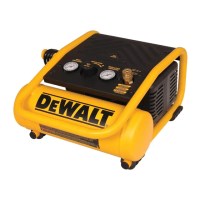
Do you have a question about the DeWalt D55140 and is the answer not in the manual?
| Brand | DeWalt |
|---|---|
| Model | D55140 |
| Category | Air Compressor |
| Language | English |
Identifies and locates main parts including switches, gauges, regulator, and valves.
Indicates an imminently hazardous situation leading to death or serious injury if not avoided.
Indicates a potentially hazardous situation that could result in death or serious injury if not avoided.
Indicates a potentially hazardous situation that may result in minor or moderate injury if not avoided.
Indicates a potentially hazardous situation that may result in property damage if not avoided.
Warning to read and understand the manual for safety, operation, and maintenance before using the unit.
Warning about chemicals in dust from construction activities and their potential health risks.
Electrical sparks can ignite flammable vapors, causing fire or explosion.
Operate in ventilated areas, free of combustible materials and vapors; maintain distance from spray areas.
Ensure adequate ventilation by keeping openings clear and operating at least 12" from walls.
Operate in clean, dry, well-ventilated areas and remain attentive; keep children away.
Turn off and unplug when not in use; do not operate unattended to prevent injury or damage.
Compressed air can contain contaminants causing serious injury or death; never use for human consumption.
Use certified filters and safety equipment for breathing air; work in well-ventilated areas with safety gear.
Failure to drain, modifications, or tampering with safety valve can lead to tank weakening and explosion.
Drain tank daily, do not drill/weld/modify tank, do not alter safety valve or operating pressures.
Exceeding pressure ratings of tools or inflatables can cause them to explode or fly apart.
Follow manufacturer recommendations, never exceed maximum pressure ratings for attachments.
Improper use of electrical device can cause shock; unqualified repairs may lead to electrocution.
Do not operate outdoors in rain or wet conditions, keep covers intact, use qualified service personnel for repairs.
Failure to ground can cause shock; ensure proper grounding, voltage, and fuse protection for the connected circuit.
Compressed air stream can cause soft tissue damage and propel objects, causing injury or property damage.
Always wear certified eye protection; never point nozzle at people or animals; turn off and bleed pressure before maintenance.
Touching exposed metal parts like the head or exhaust can result in serious burns.
Avoid touching hot parts during or immediately after operation; allow unit to cool before maintenance.
Moving parts like the pulley or belt can cause serious injury if contacted by clothing or body.
Keep guards intact; keep hair, clothing, and jewelry away from moving parts and air vents.
Unsafe operation can lead to serious injury or death to yourself or others.
Understand manual, keep area clear, keep children away, do not operate when fatigued or under influence, preserve safety features.
A portable compressor can fall from elevated positions, causing damage and serious injury or death.
Operate on a stable, secure position; never on roofs or elevated locations; use extra hose for high reach.
Prolonged exposure to noise may contribute to hearing loss.
Always wear certified hearing protection (ANSI S12.6).
Details on switches, valves, and gauges for monitoring and operating the compressor.
Information on the quick connect, drain valve, cooling system, and pump.
Guides on securely attaching hoses to the quick connect to prevent whip or disconnection.
Instructions for safely removing hoses, ensuring pressure is regulated to zero to prevent hose whip.
Emphasizes the necessity of proper grounding to prevent electrical shock and electrocution.
Specifications for using extension cords, including wire gauge, length, and grounding requirements.
Steps to ensure the compressor is ready for operation, including switch position and circuit connection.
Warning to read manual before operation.
Instructions for the initial run-in period to ensure proper compressor function and prevent damage.
Steps for starting the compressor, including checklist and pressure adjustment.
Steps for performing maintenance safely, including turning off power and draining the tank.
Procedure to test the safety valve's functionality to prevent over-pressurization and potential explosion.
Instructions for safely draining condensation from the air tank to prevent corrosion and weakening.
Information needed for service calls, including model and purchase details.
Emphasizes using DEWALT authorized service centers for safety and reliability.
Details the warranty coverage and limitations for DEWALT heavy duty industrial tools.
Information on how to obtain free replacement warning labels if they become illegible or are missing.
Definitions for CFM, SCFM, and PSI, units measuring air delivery and pressure.
Definitions for Code Certification, Cut-In Pressure, and Cut-Out Pressure related to compressor operation.
Definitions for Branch Circuit and Duty Cycle, relevant to the compressor's electrical and usage parameters.
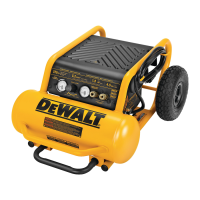
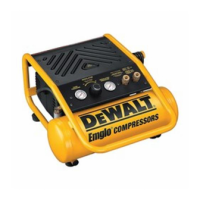
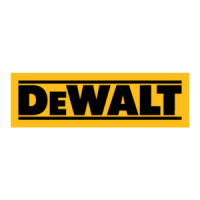
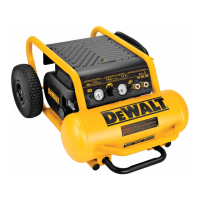
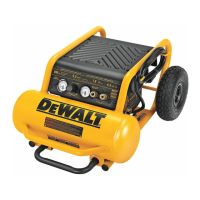
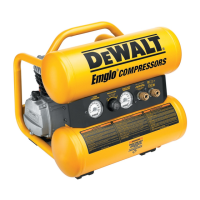
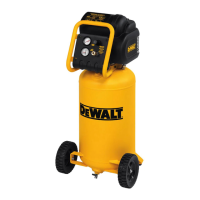
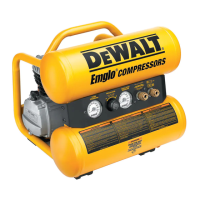
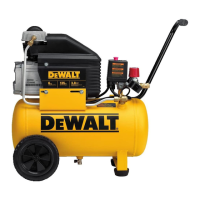
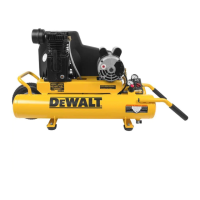
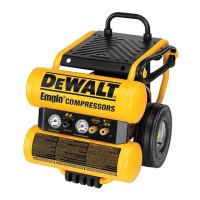
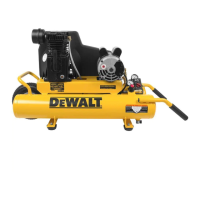
